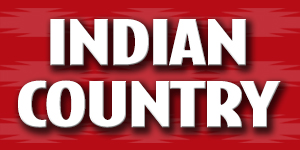LCPD hosts open house to provide insight into program
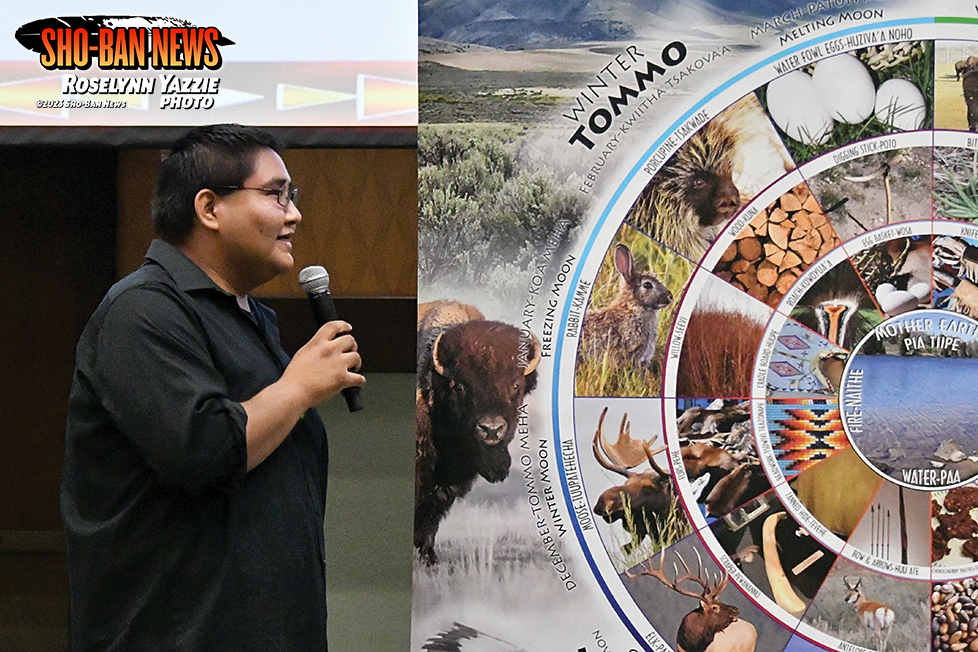
LCPD’s Bannock language apprentice Dillin Diggie speaks about the language classes offered through the program at the open house on November 25.
By ROSELYNN YAZZIE
Sho-Ban News
FORT HALL — The Shoshone-Bannock Tribes Language & Cultural Preservation Department (LCPD) hosted an open house on Saturday, November 25 to give the community a glimpse of their program’s work.
Staff in attendance were introduced, including Brenda Honena who works with an ANA grant on curriculum development; Dillin Diggie is the Bannock language apprentice; Anna Bowers is with the Heritage Tribal Office; Manuelita Waterhouse is an ancestral researcher; Velda Racehorse does archives; Stephan Kniffin works with Original Territories as a temp; Sonya Wadsworth is a videographer; Theresa Bache is the administrative assistant; Nolan Brown is the Original Territories Historical Research manager; Bailey Dann is an Original Territories Historical Researcher; Louise Dixey is the cultural resources director; Rosemary Devinney is the Tribal Museum director; other language instructors are Zelphia Towersap, Tony Shay Moon Elk, Daisy Dixey, and Mardel Butler.
During her welcome, Louise Dixey encouraged participants to take part in all that they could, as well as asked them to visit the tables set up to find out more information, and fill out a language survey that would be used to get input for the program.
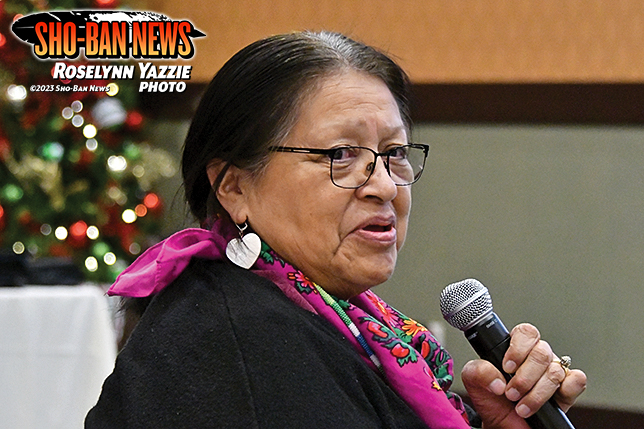
LCPD cultural resources director Louise Dixey gives a welcome
address to participants.
Dillin Diggie talked about the language classes offered, which are taught in both Bannock and Shoshone. Classes are taught on Zoom and in person from 12 p.m. to 1 p.m. at the LCPD Conference Room Monday through Thursday. Bannock is taught on Monday and Wednesday and Shoshone is taught on Tuesday and Thursday. To access Zoom call 208-236-1187.
He showed an example of what they teach to youth in Bannock Creek during the summer. They also help with different interpretation projects within their department and other tribal departments. Some of the projects are signage and another is helping to interpret the Big Game Code into the Shoshone language, also place renaming, which is work done to replace derogatory names.
Diggie showed an example of the Bannock and Shoshone orthography, which is the alphabet in the language that was adopted using an English phonetic alphabet. However, some of the sounds are different than the English language, mainly the vowel sounds. It has given them the opportunity to work on the language dictionary in Bannock and Shoshone. They are taking comments on what they can do to improve the dictionaries in their final draft forms.
Dixey explained one of the reasons for the open house was to give the community a chance to hear the different dialects in speaking.
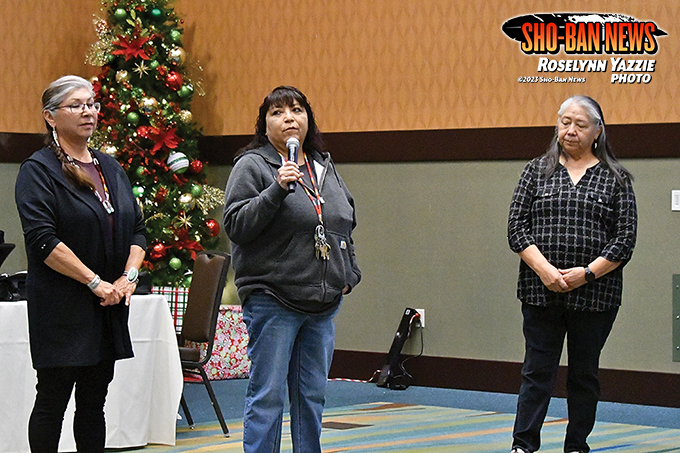
LCPD’s Heritage Tribal Office give an introduction. HETO staff, from left: Anna Bowers, Larae Bill
and Carolyn Smith at the open house.
The Heritage Tribal Office (HETO) staff, with Carolyn Smith, Anna Bowers and Larae Bill, gave a presentation. Smith is the cultural resources coordinator. All three of them are involved with different aspects of cultural surveys. HETO was established in 1992 and is funded by the Department of Energy office, although but they’ve been under LCPD within the last five years. They’re also looking to hire an Entry Level Cultural Resources Technician in 2024, which will basically be a trainee in the field.
HETO’s objectives are to protect and monitor the Shoshone-Bannock original ancestral territory and make sure DOE is complying with all federal cultural resources laws on the INL with their activities and missions. They also conduct site visits, assist with research projects at INL do tours for the Fort Hall Business Council, tribal members and students, and participate in DOE working groups.
They do technical consultations with Bureau of Land management, Forest Service, Park Service, Fish and Wildlife, and DOE. They also consult on the Native American Graves Protection & Repatriation Act, Archaeological Resources Protection, National Environmental Policy Act, and Section 106 of the national Historic Preservation Act.
Tribal youth, Susan Avila Dixey and Fort Hall Elementary Little Princess Ellanis Stagner, provided entertainment during breaks by performing circle dance songs.
Sho-Ban News presented two videos on cultural events from the summer that featured the Bannock Warrior Challenge and Pine Nut Gathering and Seed Banking Project at the City of Rocks.
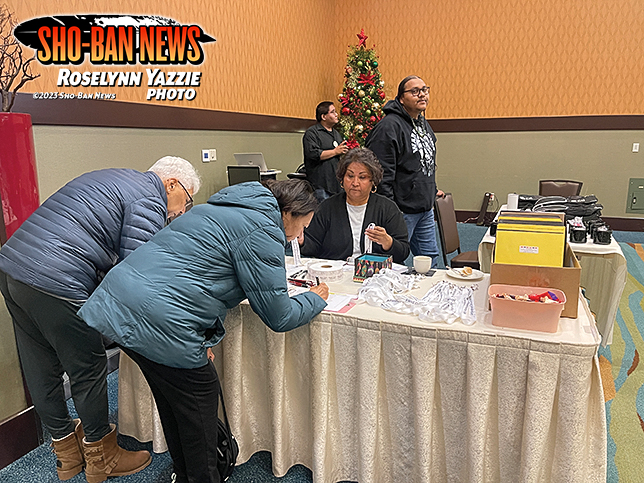
LCPD Administrative Assistant Theresa Bache checks in participants.
Nolan Brown spoke about some of the highlights of Original Territories Historical Research, it was established by the Fort Hall Business Council and started as the Lemhi Project to research ancestral land claims in Idaho and southwest Montana. Additionally they support research projects concerning the homelands of the Shoshone-Bannock Tribes. They conduct research and coordinate information, and educational efforts, such as interpretive exhibits, curricula presentations for both tribal members and the public.
Brown talked about the origins of the Fort Hall Reservation and how the tribal people have a deep history in not only this area, but all over.
He said one of their main goals is to make their presence known in those areas, which is why the culture committee and the Sho-Ban Tribes invest in the cultural events during the summer.
“Like the Virginia City Treaty Day Gathering, you know we go back to Montana every year so that we can be a voice and educate the public,” he said.
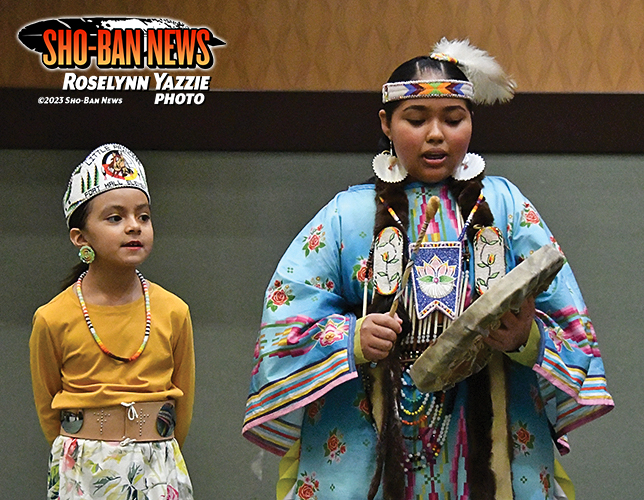
Ellanis Stagner (left) and Susan Avila Dixey sing circle dance songs.
Shoshone-Bannock Tribal Museum Director, Rosemary Devinney believes history is really important and said everyone should learn about their family heritage.
She was hired in May of 1996 and said her job is to basically keep the museum open.
The museum building was built in 1985. It was designed after the district lodges. The museum was closed for a period of time and used as a storage but in 1993 it was reopened.
Devinney said, “The purpose of the museum is to conserve and preserve our cultural heritage.”
Devinney learned more about the history herself through much research.
The Tribal Museum is open in September through May, Monday through Friday from 9:30 a.m. to 5 p.m. and June through August it’s open daily from 9:30 a.m. to 5 p.m. There’s a small admission charge for non-tribal members and tribal members with identification card are free.
In closing, Dixey said she appreciated everyone for attending and asked Ellanis Stagner to sing another circle dance song.




